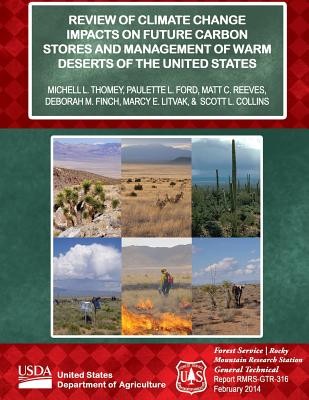
- We will send in 10–14 business days.
- Author: United States Department of Agriculture
- Publisher: CreateSpace Independent Publishing Platform
- Year: 2015
- Pages: 34
- ISBN-10: 1511647698
- ISBN-13: 9781511647694
- Format: 21.6 x 28 x 0.2 cm, softcover
- Language: English
- SAVE -10% with code: EXTRA
Review of Climate Change Impacts on Future Carbon Stores and Management of Warm Deserts of the United States (e-book) (used book) | bookbook.eu
Reviews
Description
Reducing atmospheric carbon dioxide (CO2) concentration through enhanced terrestrial carbon storage may help slow or reverse the rate of global climate change. As a result, Federal land management agencies, such as the U.S. Department of Agriculture For-est Service and U.S. Department of the Interior Bureau of Land Management, are implementing management policies to increase carbon storage. However, information on how projected southwestern climate changes might affect the balance between CO2 uptake and loss on semiarid rangelands is not easily accessible to land managers. We summarize studies that focus on key components of carbon exchange, including photosynthesis, soil respiration, and plant productivity, across the warm deserts of North America to determine if common trends exist that can be utilized in management. We also provide an overview of how management practices can influence carbon sequestration in this region and discuss the U.S. Department of Agriculture Forest Service Climate Change Scorecard. Since desertification is projected to increase in the future, management strategies that increase carbon sequestration or decrease carbon loss are especially important. This requires managers to thoughtfully consider management practices that do not impede sequestration during critical times. For a popular version of the GTR see Rangelands February 2014.
EXTRA 10 % discount with code: EXTRA
The promotion ends in 18d.23:17:04
The discount code is valid when purchasing from 10 €. Discounts do not stack.
- Author: United States Department of Agriculture
- Publisher: CreateSpace Independent Publishing Platform
- Year: 2015
- Pages: 34
- ISBN-10: 1511647698
- ISBN-13: 9781511647694
- Format: 21.6 x 28 x 0.2 cm, softcover
- Language: English English
Reducing atmospheric carbon dioxide (CO2) concentration through enhanced terrestrial carbon storage may help slow or reverse the rate of global climate change. As a result, Federal land management agencies, such as the U.S. Department of Agriculture For-est Service and U.S. Department of the Interior Bureau of Land Management, are implementing management policies to increase carbon storage. However, information on how projected southwestern climate changes might affect the balance between CO2 uptake and loss on semiarid rangelands is not easily accessible to land managers. We summarize studies that focus on key components of carbon exchange, including photosynthesis, soil respiration, and plant productivity, across the warm deserts of North America to determine if common trends exist that can be utilized in management. We also provide an overview of how management practices can influence carbon sequestration in this region and discuss the U.S. Department of Agriculture Forest Service Climate Change Scorecard. Since desertification is projected to increase in the future, management strategies that increase carbon sequestration or decrease carbon loss are especially important. This requires managers to thoughtfully consider management practices that do not impede sequestration during critical times. For a popular version of the GTR see Rangelands February 2014.


Reviews